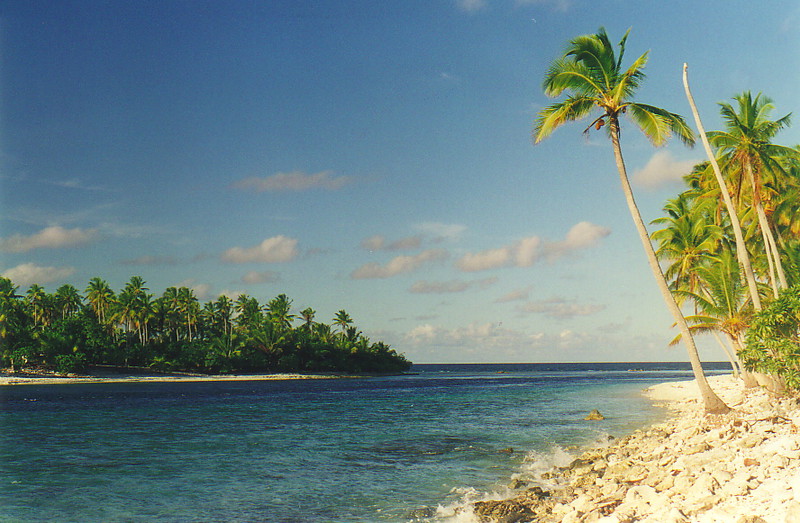
The ocean passage from the Gambier Islands to the atoll of Amanu – some four days' travel north-northwest to where the large atoll Hao dominates the map – was as uncomfortable as I thought it would be. I only lost one meal to the fish, and we didn't get hit by any storms, but having already done one hugely unpleasant ocean passage (and a particularly long one too, judging by the reaction of the other yachties in Rikitea) I wasn't exactly keen on doing any more.
At least this time the yacht didn't pitch and roll as badly, and there were only two of us on board, which prevented overcrowding, but even though it was only a four-day trip to Amanu, I was desperate to hit land again. Memories of the trip from New Zealand flooded back – getting up at 3am while waves crashed over the side of the boat, the three of us desperately trying to reef the main sail while the wind whipped us to the bone for an hour; or having to put up with the sheer, exasperating boredom of 28 days on the sea – but while these feelings didn't apply to the four days ambling through the smooth, pleasant-weather sailing of the trade winds, I still had to grit my teeth and persuade myself that Zeke was simply a means to an end, that end being the islands of incomparable beauty that we were exploring.
We eventually reached Amanu on Sunday 22nd June, after chalking up another 450 nautical miles. Let's not dwell on the sailing and instead move swiftly on to the important part: the destination of Amanu.
Navigating the Pass
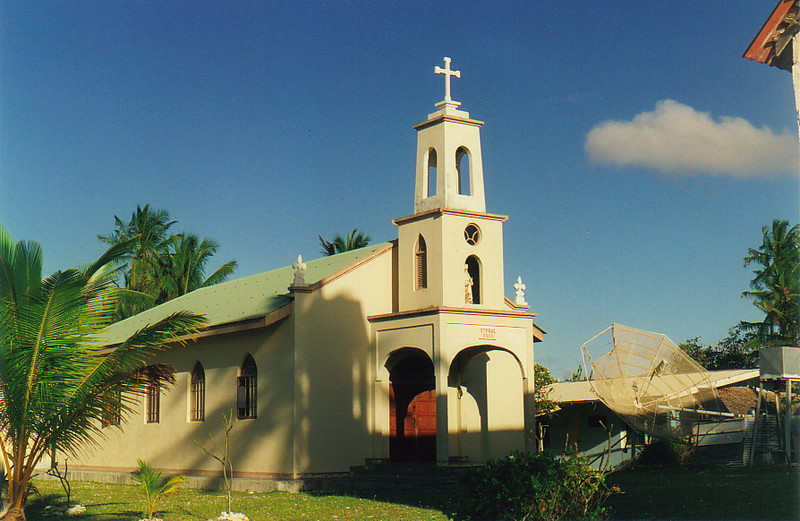
«Non, la bas c'est la passe deuxième,» said Marerenui, shaking his long-hair and looking for all the world like a Polynesian Shaggy temporarily without his Scooby Doo. «Vous voulez la première; c'est deux kilometres au sud.»
Squinting through the rain, I didn't quite know what to make of Amanu. Our progress through the Dangerous Archipelago (the old name for the Tuamotus) had proved that without a GPS – the electronic gizmo that gives your latitude and longitude from satellite fixes – life in the Tuamotus would not only be dangerous, it would be downright suicidal. The Tuamotu atolls are invisible until you're about five miles away from them – since they have no mountainous islands in the Tuamotus as they do in the Gambiers – and before you know it you can be run aground on a coral reef and sinking in the South Pacific with no means of escape. In the days before GPS, navigation by sextant would be petrifying in such an area, especially if the weather was cloudy, as it had been for most of our passage. Even with a GPS, it's no picnic.
Amanu is a classic atoll, an oval-shaped ring of coral scattered with coconut palms and breaking surf, with only three passes into the lagoon. The problem, however, lies in actually getting through the passes, because the whole atoll is hugely tidal; the sea rushes into the narrow gaps in the reef, creating huge, swirling currents that suck in unsuspecting boats, and six hours later the tide turns and Amanu disgorges itself of all the flotsam it's drawn in, like some huge sea monster's lung. We arrived at what we thought was the main pass, and all we could see was a torrent of foamy water, rushing out of the lagoon over sharp rocks, jutting reef and treacherous-looking sand bars. Coupled with the squalls that blew in to add to the already atrocious visibility, and we were rapidly getting cold feet as to getting into the lagoon.

Our sketchy information and lack of good charts didn't help. Until the last couple of years the whole of the south Tuamotu archipelago was interdit, as it was home to the French government's nuclear testing and secret military training; nobody, absolutely nobody got in, bar the locals and the legionnaires. Now the exclusion zone is limited to an area around Mururoa and Fangatuafa atolls, home to the last nuclear tests in 1995, and you can go anywhere else without hindrance... that is, if you can get the information you need to explore the archipelago. All the guidebooks still list the Tuamotus as a no-go area, there is no information on passes, no up-to-date charts of the area, and all the yachties we'd met had the same problem: ils ne savent pas de tout. The typical reaction of the unadventurous sailor is to go straight to Tahiti, leaving the Tuamotus to the east, but the captain and I wanted to explore the Forbidden Zone and had spent some time doing the detective work on places we could visit in the southern Dangerous Archipelago.
Our options were limited by only considering atolls with passes into the lagoons; anchoring off the outside of an atoll is normally impossible because the ocean floor drops off too steeply on the ocean side, and even if you can drop anchor, it's fatal if the wind turns and blows you onto the reef. The atolls in the southern Tuamotus that have passes are small in number: there are the Gambiers, where we'd already been; Mururoa, where we couldn't sail without going via the inside of a French prison cell; Hao, home to the main military base in the Tuamotus, and not too desirable for just that reason, with its jets and legionnaires; Makemo, not far from Hao; and Amanu, an intriguing spot if only because there was so little information on it anywhere. The other atolls were either impossible to get into or were privately owned by pearl farmers, and were therefore out of bounds.
Our research had thrown up just two facts about Amanu: there were two passes into the lagoon (though we found out later there are actually three), and they were both ferociously tidal, far too swift at high or low tide for a yacht to motor through. In the books we also found a formula linking the time of moonrise and moonset to the best time to enter the passes, so we tried to measure the times of the moon's passage as we sailed from Mangareva, though without any success; it was far too cloudy. The electronic almanac I'd picked up off the Internet for my faithful palmtop turned out to be as trustworthy as a cockney trying to sell genuine Yves Saint Laurent perfume for five quid on Oxford Street, so we arrived with very little to go on. Looking at the boiling inferno that we were supposed to tackle we felt our resolve buckle, despite our four-day journey to get there. Dejected, we decided to scoot south down the coast of the atoll to see if we had possibly missed another entrance.
Marerenui to the Rescue
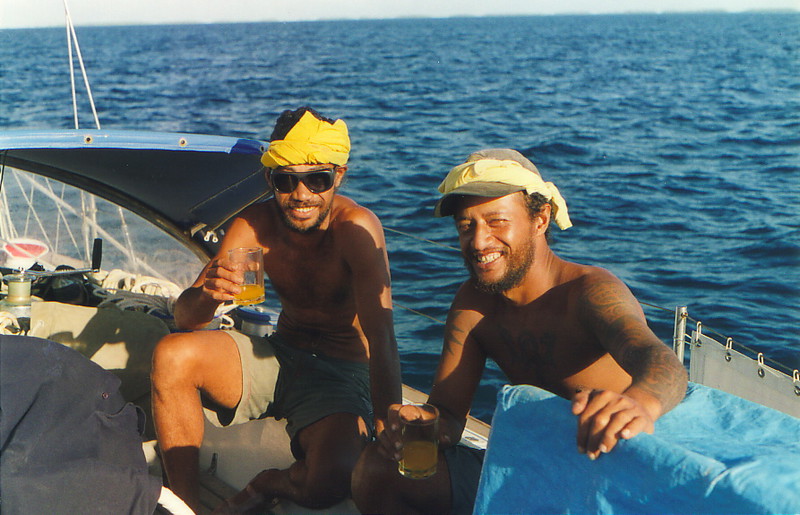
That's when the speedboat came planing over the surf, pounding along with three brown-skinned natives bouncing up and down in a synchronised dance that's instantly familiar to anyone who has witnessed insane driving on tropical islands. We flagged them down, and in broken French I asked them about the pass. Marerenui, Angelo and Laurent were to turn into our saviours.
'That's the second of the three passes you've been looking at,' said Marerenui, in one phrase making the facts and figures we'd creamed about Amanu look completely reliable. 'You don't want to go through that one unless you've been drinking too much champagne; the best pass is down there, by the village.' And hopping onto Zeke with Angelo, leaving Laurent to motor off back home at breakneck speed, Marerenui pointed us south to the real pass. To be honest, it didn't look that much more encouraging.
'Give it an hour and a half,' he said, 'and then we can motor into the lagoon.' The hour and a half was spent chatting in pidgin French, drinking coffee, listening to Bob Marley, and wondering quite what was going to happen to the apparent Niagara by two o'clock in the afternoon. But sure enough, after one and a half hours, the pass was as placid as a baby on methadone, and we set off, me at the wheel, responding to gauche, droit and tout droit with more confidence than the usual port and starboard, which I've never really managed to get the hang of.

It might have looked passive, but our new-found friends' conversation was nagging at the back of my mind. There had been two yachts run aground on the reef in recent years, resulting in one angry Frenchman who lost his boat after getting drunk and screwing up his entry, and one even angrier German who had lost his life because he was playing his guitar in the cockpit and didn't realise the reef had sucked him in. The locals had to pull the latter's body from the wreckage and make sure it went through the right channels, something the owner of the body had quite obviously failed to do in the last moments of his life. Considering that Amanu gets about five or six yachts visiting it every year, that's quite a high fatality rate.
We managed to get through, though, relieved and somewhat thrilled by our introduction into the lives of the locals. We anchored, after politely declining the offer of tying up to a rusty steel buoy in the harbour which would have scratched the hell out of the boat had the wind blown us onto it, and thanked our saviours for their kindness. However, having spent the last four days in watch shifts of three hours – three on, three off for 24 hours a day, somewhat ruining the sleep pattern – we left the boys to go off and play their Sunday afternoon game of volleyball on the village green, and instead accepted a dinner invitation from Marerenui for that evening, by which time we'd be rested and clean.
Amanuan Hospitality

We showered and hit the sack for a couple of hours' rest, but I was rudely awoken after an hour by the arrival of another boat, this time heralding another type of native: the Gimme-Something. Most of the locals we'd met so far had been incredibly kind, handing out fruit and advice freely and not expecting anything in return. The Gimme-Something, however, equates 'yacht' with 'rich American' and pays a visit to see what he can get. The two Gimmes who turned up, with a young son in tow, enjoyed the tour of the boat I gave them in pidgin French, declined the offer of une tasse du café, and after some idle banter revealed their mission.
«Avez-vous du bier?» inquired the scrawny one with the moustache. «Du vin? Du whisky?»
«Non,» I replied, almost truthfully, and had to go through the same routine three times before they finally lost interest and went back to the village. I explained that we'd failed to stock up in New Zealand – a mistake in retrospect, because rum is as valuable as gold in these islands – and that alcohol had been too expensive for us to buy in Rikitea. The reply was that you couldn't buy alcohol in Amanu for any price, and that you had to go to Hao to get it; all the natives had was tobacco and marijuana, which to me didn't sound like too bad a deal, but they wanted beer. Or wine. Or whisky. But all I wanted was some sleep, and eventually they left me to grab some while I could.
The evening with Marerenui was quite, quite different; the family were extremely polite, extremely generous, and extremely patient with my stilted communications and the captain's grammar-free string-of-vocabulary attempt at French. We arrived, kicked off our shoes (as one should do when entering houses throughout Polynesia), and sat down at the kitchen table for a feast. It struck me as odd that there were only two places laid, and as we served ourselves portions of ris, poulet, raw bonito and some superb poisson à soy, drinking jus de coconut straight from the shell, we realised that we were the only ones eating; the family looked on, making conversation and obviously pleased to see such healthy appetites. There were some slightly worrying moments as I realised I knew nothing about Polynesian manners: does one eat with one's hands, or does one eat everything with the one fork provided? And the coffee, served in a soup bowl: does one slurp it from the bowl like a parched desert nomad, or use the teaspoon to drink it like soup? And should one bring gifts to the house, as we had? And, as I recalled reading, should one make sure not to admire anything too much, because Polynesian custom dictates that the host must give that something to the visitor? Whatever, we scoffed, and we scoffed a second helping, and then we rounded it off with un peu de glace and un cigarette, stretching my knowledge of French superlatives to the utmost limit; how many times can you say «le repas est tres bon, magnifique, superbe» and so on?
Fumbling in French
It soon became apparent that my French was pretty poor and I understood only a little, though luckily Hinano, Marerenui's wife, spoke much clearer and simplistic French than the men, probably because she was used to talking to her kiddies. Still, the French that I did have was enough for basic communication, and with a few simple inventions I managed to turn the language into my own communications tool.
The first rule I followed was the 50:50 sex rule; learning the sex of nouns in French is probably the hardest vocabulary challenge to a speaker of a generally sexless language like English, so I made up the sex of each noun as I went along, using le for about half, and la for the rest. The second rule was to keep talking, and if I couldn't remember the word for something, I simply signed it, or just grunted in a Gallic shrug and tried to transmit what I meant psychically. Third, I kept trying to sound enthusiastic about simply being able to communicate, with choice phrases like «Le Bob Marley: il est la langue universale, eh!» as reggae beats throbbed out into the jungle. This approach seemed to work most of the time.
On the other hand, the language barrier was sometimes just that. When I asked the boys what they did with their time, they replied, «Pechant, copra et la femme», rhythmically pulling on imaginary female hips in much the same way as drunk package holidaymakers do in discos in Ibiza and Majorca in time to the latest Euro-pop one-hit-wonders. I initially assumed that this meant they had their way with loads of women but, of course, femme is not only the word for woman, it also means wife, and all the boys were saying was that they fished, made copra and spent a lot of quality time with their wives. I can think of worse ways to while away the days.
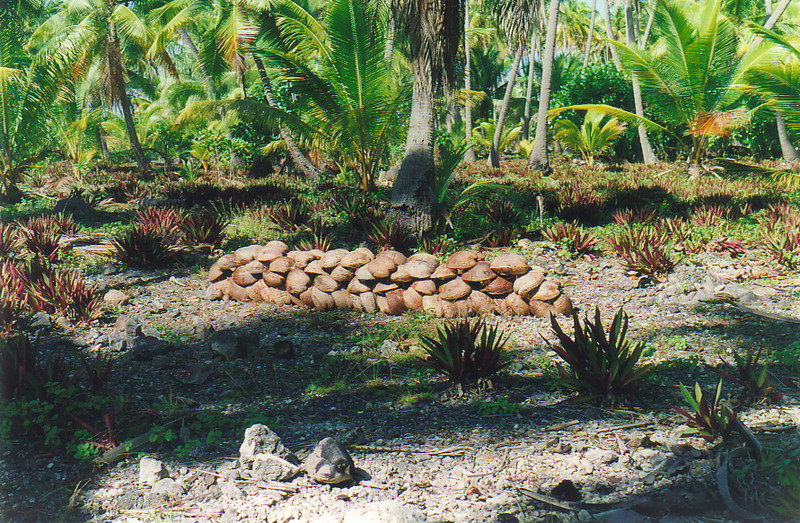
We learned plenty from our hosts. Marerenui was a fisherman some of the time, and a copra farmer for the rest. Copra is dried coconut pulp, laid out in the island sun, and is exported from most of the islands in Polynesia; it is used to produce coconut oil, which is in turn used to make such varied items as soap, margarine and nitro-glycerine. It's a lucrative trade, and has provided the 200 Amanuans with a standard of living that isn't quite up to Mangarevan standards (where everyone has expensive four-wheel-drives due to the thriving pearl farming there), but which is pretty luxurious by normal desert island standards. Marerenui's house, perched by the breaking surf at the entrance to the pass, from which a soothing sound of pounding currents lilted all night, was about as well positioned as a house can be. If Amanu had been a tourist resort, Marerenui would have been a property tycoon.
In fact the coconut, the staple product of Polynesia, deserves an aside of its own. The coconut palm, the ubiquitous symbol of tropical paradise, grows just about everywhere; the coconuts themselves, if allowed to mature on the tree and fall off, will germinate, sending out roots from two of its three 'eyes', and a leafy stalk from the third. The nuts also float, and coconuts can be seen drifting through the ocean currents, eventually landing on other islands and populating them with coconut palms. The trees themselves are used for building material, making mats and other objets d'art, and for making clothes.
However the nut, which comes inside a fibrous husk (itself used for making rope) is the real source of wealth. After one year growing from a flower into a full coconut, the husk is greeny-brown and the nut drinkable; chop off the husk, smash off the top, and drink down that wonderfully sweet coconut juice, something that tasted good in Mangareva, but which proved really luxurious and as sweet as nectar in Amanu. As the coconut ripens further, the milk gets weaker and the flesh gets thicker, becoming the familiar white pulp that we know and love in the West. Eating flesh from a fresh coconut knocks the sterile western version into a cocked hat, and sliced and sautéed in teriyaki sauce it makes a wonderful nibble for between meals.
So that's the coconut: it provides food, drink, shelter, body covering, ornamentation, copra and, possibly the most important contribution, it gives you somewhere to hang your hammock as you sip a rum and coconut juice. Ah, the tropics...
So we idled away the night, chatting in fifth-form Français about life on the island, the trials and tribulations of living on a yacht, and all of the other stuff you talk when you don't know enough vocabulary to get deep in discussion. We discovered how the locals swam in the pass when the current was flowing, using fins and masks to spear the fish as they struggled against the flow. We found out that the nuclear atoll Mururoa was apparently home to «tout le merde de France» and that the local policeman on Amanu, who took over from Marerenui's late father-in-law, was very strict. Then there was the supply ship, which arrived every two weeks, servicing Hao, Amanu and Mangareva among others, and from which everyone bought direct because it was cheaper than the prices on the atoll (a hand-sized piece of frozen beef cost about US$30 from the local shop). The supply boat had arrived the day before, which explained the frozen chicken and ice cream we'd scoffed.

Then there were the flights to Tahiti, only a few hundred miles away but an eye-watering US$520 for a one-way flight (though the flight is free if it's a trip to the hospital there); the security blanket that one of the little kids was clutching throughout the night, proving that the world of the comforter transcends mere cultural barriers; and the wonderful cushion covers that Hinano spent her spare time on... it was an evening of interesting discoveries.
Soon enough the three little kids were starting to yawn and we thanked our guests using some Tahitian words they'd taught us during the evening, and got a lift back to Zeke in Marerenui's boat, the same boat he used to zip across to Hao in one-and-a-quarter hours. The boats in the Tuamotus are interesting. Every one of them has a huge engine – and by huge I mean at least 40 horsepower, a meaty outboard if ever there was one – and every engine is brand spanking new. We assumed there was some special deal going on in the South Pacific with outboards, but nobody in Amanu has a car – there's one communal vehicle on the whole atoll – so the outboard is the equivalent of the family car. Still, these engines would cost a fair amount in the West, and the houses are pretty luxurious, so there's money round here somewhere. Whatever the cost, the local skiffs have no trouble surging through the pass at any time of day, chopping through the waves like manic surfers. (Talking of which, Marerenui told us about this mad teacher from Hao who comes over to Amanu every weekend to teach the kids, and who goes surfing on the outside of the reef every weekend too. Looking at the reef, that's a teacher with lot of nerve... which is surprising, considering he's an Englishman rather than a surf-mad Aussie or a sun-bronzed Californian.)
And all this in a village with one shop, two churches, 200 inhabitants and no other yachts to be seen. Compared to neighbouring Hao with its 1000 people, hundreds of military personnel, strings of shops and the noisy airstrip, Amanu is a beautiful, unspoilt haven.
Saying Goodbye to Amanu
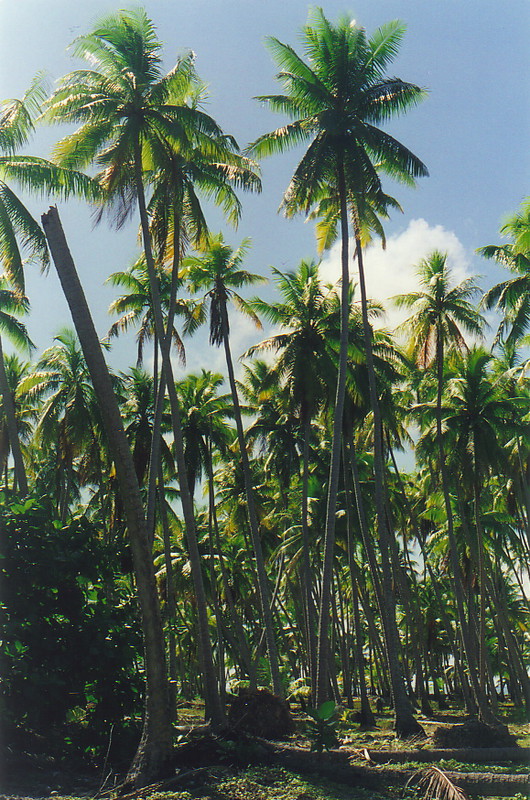
Our final day on Amanu was a perfect example of the extreme kindness of the Amanuans. Marerenui, finding out that it was our last day, invited us to dinner again, laying on a wonderful spread of poisson cru (raw bonito in vinegar, quite a delicacy), chicken, rice, pasta, coconut milk and entertainment.
We talked all night, with conversation returning to the same topics as covered in all my French chats: snorkelling, weather, excellence of food, kindness of hosts, and so on. We talked about our exploration of the island the day before, where we'd wandered through the copra fields, finding beautiful beaches with incredible coral drop-offs just off the shore; here we swam among sharks, coral cod, amazing parrot fish, and coral that had to be seen to be believed. We talked about fishing, copra making, pearls, the other islands we could visit, and before long the meal was over and the chess began.
Yes, out came the chess set, and Daniel, a friend of Marerenui's who had come to visit, proceeded to have two extremely close games with Rob, the result ending up at one game each. Then Marerenui and I sat down for a contest, but he must have been having a bad day, because I won both of them, and I'm genuinely no chess player. It was a thrill, though, being the centre of attention as other locals wandered in and out of the house, some staying to watch the game, some just passing through. It also meant we were communing without conversation, a relief after the struggle of thinking in French all the time.
The final act of kindness came as we stood up to leave, some five minutes before the electricity was due to be killed. We had brought a little present – a half-bottle of sake, left over from Napoleon's visit back in Mangareva – but we were unprepared for the wonderful shell necklaces Marerenui presented us with, garlanding our necks as if we were Olympic medal winners. We also got two beautiful spider conch shells – quite how they removed the inhabitants I don't know, considering how we'd had to smash the hell out of the shells to eat them in Mangareva – and a couple of red papaya, as sweet and succulent as they come. We were escorted back to our dinghy, the end of another evening where I was struck dumb by the kindness and generosity of the island people.
Not surprisingly, I was loath to set off for the next atoll, Makemo, on ; in retrospect, I had good reason to worry.